Using a Knife to Cut Fresh Flowers

Professional florists and floral enthusiasts can learn how to cut flowers for greater efficiency and increased floral display time. Many designers learn how to create beautiful arrangements, achieving design principles and harmonious blends of elements, but they do not master the use of a cut-flower knife. Learning how to use this versatile tool takes just a bit of time and patience, and will make designing easier. It will also enhance vase life, or the amount of time flowers remain beautiful and useable.
Scissors cut through flower stems by cutting and smashing at the same time. As plant tissues are smashed, they release their cell contents. Vase water in arrangements made with stems cut with scissors becomes cloudier faster than those with knife-cut flowers.
Simply put, sharp knives make clean cuts and do not pinch water-conducting vessels the way scissors can. This fact alone makes them one of the most important, versatile tools in the floral designer’s toolbox. If you know how to use a knife properly, you will not fear it, but see it as a necessary and handy tool. Its benefits make it a necessity for working with fresh flowers.
Characteristics of a Cut-Flower Knife
Cut-flower knives have a blade of about 2–3 inches (5.0–7.6 cm) in length. One side of the blade is sharpened, while the other remains unsharpened. This is a critical feature of a cut-flower knife because the unsharpened side of the blade is held against the fingers. A double-edged knife is unsafe and not appropriate for floral use. Many designers prefer a folding knife, which makes the tool easy to carry in a pocket or tool kit. Some cut-flower knives have hooked tips and are preferred by some designers, but results are about the same.
A cut-flower knife must be sharp; therefore, it should only be used to cut soft, herbaceous stems. Never use a cut-flower knife to cut through Styrofoam or similar polystyrene products that quickly dull blades. Keep the knife for its intended purpose only—for cutting flower stems.
Cutting Fresh Flower Stems with a Knife
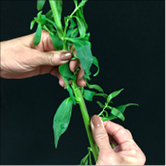 Step 1
Step 1
Remove any foliage that may fall below the water line in a floral container. They contribute to the bacterial content of water.
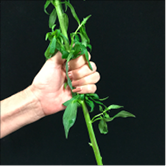 Step 2
Step 2
If you are right-handed, hold the flower stem in your left hand, underhanded. If you are left-handed, hold the flower stem in your right hand, underhanded; reverse the instructions that follow.
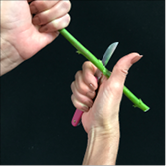 Step 3
Step 3
Hold the cut-flower knife low in your right hand. Keep your right hand relatively rigid. Hold your thumb parallel to the knife, not allowing it to touch or cross the blade. The correct positioning of the fingers on your right hand appears like a “thumbs up” sign.
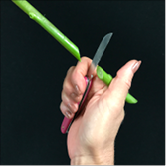 Step 4
Step 4
Problems and Snags
When you’re learning to use a cut-flower knife, make sure not to jerk the flower stem through the blade. Some stems are weak, and flower heads can be snapped from the stem. It is easy to lose track of the bloom end of the stem while concentrating on the lower area you’re cutting. You may accidentally jab the delicate flower into a wall or other surface. These mistakes sometimes happen when designers are learning proper stem-cutting techniques. However, errors are a valuable part of learning to cut flowers. You can always make a boutonniere, corsage, or floating-flower design from broken flower heads.
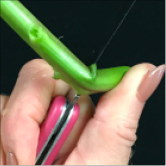
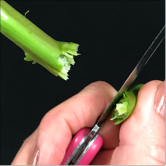
Watch a brief video of the cutting method.
Cut on an Angle
There are two reasons why it is best to get in the habit of cutting on an angle. The first is that the surface area of the cut end will always remain open to water uptake. Sometimes, many flowers are placed in bucket; so many that, instead of lying at an angle, they stand upright, in parallel lines. If stems are cut bluntly, there is a chance that the end will be positioned squarely on the bottom of the bucket, blocking water uptake.
Another reason for making angled cuts is that they lodge better into fresh floral foams. Once floral designs are created, they are almost always transported. Their journey may be from a kitchen counter to a dining room table, or the design may be carried in a delivery truck across state lines. A sharp, angled cut can be driven deeply into floral foam and stay put.
The Screwdriver Cut
Some cut-flower stems and branches are heavier and larger than others. Due to their weight and placement angle, stems can turn in the floral foam, away from the position you intended. A way to alleviate this problem is to cut the stem as instructed above, then rotate the stem 180 degrees and repeat the cut. This two-sided cut resembles a flat-head screwdriver. Once driven into the floral foam, the shape of the cut end of the stem keeps it from turning.
Other Flower-Cutting Tools
There are other types of tools used to cut both herbaceous and woody flower stems. While the professional florist must master using a knife, not every floral designer is a professional. Lengthy display time is not necessarily the goal of every floral arrangement.
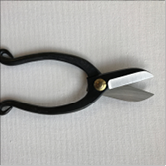
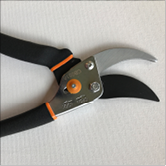
Pruning shears are a type of scissors used for cutting plant stems. Floral designers look to pruners for cutting through tough, woody stems that are not easily cut with knives.
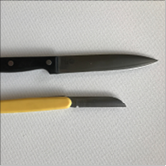
First Aid
Of course, sharp tools can be dangerous. Learning the proper method of cutting flowers with a knife should help prevent accidents. Also, be sure you’re using the correct tool for your purpose. Expect the unexpected. Even if you are well-prepared and experienced in floral design, accidents happen.
Be Prepared!
Always keep a first aid kit nearby and equipped for treating cuts. The kit should include—
- adhesive tape, elastic wrap bandages, bandage strips, and “butterfly” bandages in assorted sizes;
- nonstick sterile bandages and roller gauze in assorted sizes;
- cotton balls and cotton-tipped swabs;
- disposable non-latex examination gloves (several pairs);
- soap or hand sanitizer;
- antibiotic ointment; and
- antiseptic solution and towelettes.
Set an annual date to refresh and restock supplies.
If an Accident Happens
If you are helping another person treat a wound, first put on a pair of disposable, non-latex examination gloves to prevent transmission of blood-borne diseases.
Apply pressure to the wound. It will take a few minutes for bleeding to slow.
Carefully clean the area around the cut with antiseptic solution, towelettes, and sterile gauze. If these are not available, use fresh water.
Bandage the wound to protect it; depending on the size of the cut, you may simply use an adhesive bandage. For more serious cuts, you may need elastic wrap bandages, butterfly bandages, or nonstick sterile bandages and roller gauze. If bleeding is controlled, you may be able to go back to designing.
Seek assistance from a local health-care provider if—
- bleeding does not stop after 5–10 minutes of continuous pressure;
- the injured person is unable to move the finger; the finger is numb or bone is exposed;
- the wound is excessively deep or long;
- the wound is difficult to clean, possibly requiring antibiotics;
- the injured person has not had a tetanus shot in the last 10 years; or
- the wound develops redness, swelling, pain, or pus.
How to Sharpen the Blade
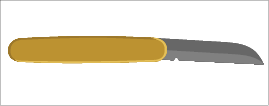
cut-flower blade has a small, angled bevel. Keep
this angle intact by sharpening the knife on a
whetstone (fine-grained tool-sharpening stone).
Add a few drops of light oil to the stone to
keep tiny metal filings from accumulating and
counteracting the knife-sharpening process.
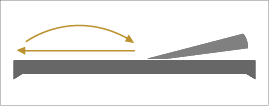
in the direction of the angle, and then lift
it for the return without dragging it across.
Repeat this process several times.
A small but noticeable burr will form
on the unsharpened side, so use a few
light strokes to remove it.
- When safety issues are a concern, as when working with children or those with limited dexterity.
- When cut flowers will no longer take up water, such as in the design of corsages and boutonnieres.
Quality floral-design tools become an extension of the designer's hand. Tools should not be shared.
Understanding Flower Life
The chief attribute of a well-made floral design is its longevity, and proper cutting tecniques are only a part of the story. Several factors impact floral longevity:
Temperature
Fresh floral designs are displayed in spaces where the ambient temperature is comfortable to humans, around 72°F (22.2°C). Appropriate storage temperature (refrigeration) of most cut flowers is around 35–40°F (1.6–4.4°C), but tropical flowers such as orchids, birds-of-paradise, and anthuriums last longer when stored around 50°F (10°C). These temperatures slow senescence, or plant tissue death. The goal is to avoid temperature extremes.
Heat speeds up the chemistry occurring within cut flowers and causes them to use up stored food more quickly, as well as unfurl petals (bloom). Flowers may not be able to compensate for such accelerated physiological changes under warm conditions, resulting in wilt. The air is just too hot for the flower to take up the amount of water it needs to stay fresh.
Temperatures falling below recommeded storage levels, hovering around the freezing point (32°F or 0°C), can cause early death of cut flowers due to lysis, the bursting of cells within tissues. Areas of leaves or petals that appear transparent or water-soaked are symptoms of chilling injury. Cells making up the tissues have torn open, causing their contents to leak within the layers of healthy cells.
Microbial Blockage of Xylem
The tube-like vessels (xylem) that facilitate water uptake in stems can be clogged by bacteria. There are many kinds of bacteria present in soil and water. Although some are beneficial to life, some can be problematic when they grow in vase water.
Scabs and Emboli
When a human gets a cut or wound, blood coagulates and forms a scab. Plants have a comparable means of keeping moisture within the stem and pathogens outside. When plant materials are cut, cells in that area are stimulated to produce suberin, a waxy material that makes up waterproof cork, or dead tissue that protects the outside of plant stems. The problem is that the scab repels water. Another problem is air-bubble blockages in stems. When a stem is cut, air is drawn into the stem rather than water from the roots and soil. Small air bubbles, termed emboli, form blockages in xylem, and water cannot pass through them. Remove scabs and air blockages by cutting the stem about 1 inch above the previous cut.
Fresh Flower Food
Ordinary tap water is fine for flowers, but vase water quality can be improved by using flower food. Commercial flower foods contain three main ingredients:
- Carbohydrates provide a food substrate to encourage flowers to bloom.
- Citric acid keeps the vase solution acidified for a few days; bacteria do not proliferate in acidified solutions.
- Biocides keep bacterial growth in check for a few days at room temperature.
Always follow manufacturer recommendations when using cut-flower foods. A diluted mix can be detrimental to vase life, providing just enough carbohydrate to enable bacterial growth, but not enough citric acid and biocide to keep it in check.
Newly introduced cut-flower food does not require flower stems to be cut in the processing phase. Once flowers are received, they need merely to be placed in the solution. Still, flowers must be cut when arranged, so there is a need to master the use of a cut-flower knife.
References
Butler, S., DelPrince, J., Fowler, C., Gilliam, H., Johnson, J., McKinley, W., Money-Collins, H., Moss, L., Murray, P., Pamper, K., Scace, P., Shelton, F., Verheijen, A., and Whalen, K. 2005. The AIFD guide to floral design. Intelvid, Flourtown, PA.
Hunter, N. 2013. The art of floral design. 3rd ed. Delmar, Clifton Park, NY.
Lewis Ivey, M. and Lunos, A. 2015. Bacterial streaming test for rapid diagnosis of vegetable bacterial diseases. LSU AgCenter, Department of Plant Pathology and Crop Physiology. PPCP-VEG-005, August 2015. https://www.lsu.edu/agriculture/plant/extension/hcpl–publications/Bacterial–Streaming–PPCP–VEG–005.pdf
McDaniel, A. 1999. R-5: Cutting tools. July 2017. http://www.hort.vt.edu/McDaniel/hort2164/R5CuttingTools.htm
Nell, T. 2017. Quality versus grades and standards: Know the difference. Floral Management. 34:48.
Scace, P. and DelPrince, J. 2015. Principles of floral design. Goodheart-Willcox, Tinley Park, IL.
WebMD. Treatment for finger injuries. July 2017. http://www.webmd.com/first-aid/finger-injuries-treatment
Publication 3121 (POD-09-17)
By James M. DelPrince, PhD, Assistant Extension Professor, MSU Coastal Research and Extension Center; David Buys, PhD, Assistant Extension/Research Professor, Food Science, Nutrition, and Health Promotion; and Susan Deblanc, Research Associate II, MSU Coastal Research and Extension Center.
The Mississippi State University Extension Service is working to ensure all web content is accessible to all users. If you need assistance accessing any of our content, please email the webteam or call 662-325-2262.


